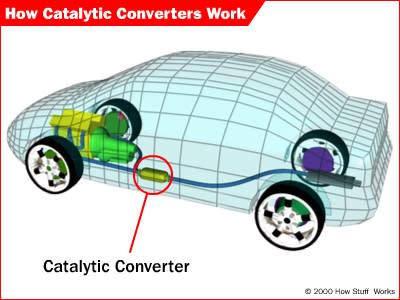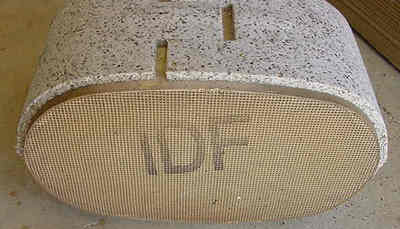What Does a Catalytic Converter Do and Why Do People Steal Them?

There are millions of cars on the road in the United States, and each is a source of air pollution. In an attempt to stem this pollution, cities, states and the federal government create clean-air laws that restrict the amount of pollution that cars can produce.
One of these auto production changes came about in 1975 with a device called a catalytic converter — but what does a catalytic converter do, exactly?
In this article, we'll go over the types of pollutants an engine produces and how a catalytic converter helps reduce vehicle emissions.
What Is a Catalytic Converter?
A catalytic converter is an emissions control device. The job of the catalytic converter is to convert harmful pollutants into less harmful emissions before they ever leave the car's exhaust system.
Catalytic converters are amazingly simple devices, so it is incredible to see how big an impact they have.
Air-to-fuel Ratio in a Car Engine
In order to reduce emissions, modern car engines carefully control the amount of fuel they burn. They try to keep the air-to-fuel ratio very close to the stoichiometric point, which is the ideal ratio of air to fuel.

Fuel Mixture
Theoretically, at this ratio, all of the fuel will be burned using all of the oxygen in the air. For gasoline, the stoichiometric ratio is about 14.7:1, meaning that for each pound of gasoline, 14.7 pounds of air will be burned.
The fuel mixture actually varies from the ideal ratio quite a bit during driving. Sometimes the mixture can be lean (an air-to-fuel ratio higher than 14.7), and other times the mixture can be rich (an air-to-fuel ratio lower than 14.7).
Types of Emissions
The main emissions of a car engine are:
Nitrogen gas (N2): Air is 78 percent nitrogen gas, and most of this passes right through the car engine.
Carbon dioxide (CO2): This is one product of combustion. The carbon in the fuel bonds with the oxygen in the air.
Water vapor (H2O): This is another product of combustion. The hydrogen in the fuel bonds with the oxygen in the air.
These emissions are mostly benign, although carbon dioxide emissions do contribute to global warming. Because the combustion process is never perfect, some smaller amounts of more harmful emissions are also produced in car engines. Catalytic converters are designed to reduce all three:
Carbon monoxide (CO) is a poisonous gas that is colorless and odorless.
Hydrocarbons or volatile organic compounds (VOCs) are a major component of smog produced mostly from evaporated, unburned fuel.
Nitrogen oxides (NO and NO2, together called NOx) are a contributor to smog and acid rain, which also cause irritation to human mucus membranes.
How Catalytic Converters Reduce Pollution
In chemistry, a catalyst is a substance that causes or accelerates a chemical reaction without itself being affected. Catalysts participate in the reactions, but are neither reactants nor products of the reaction they catalyze.

In the human body, enzymes are naturally occurring catalysts responsible for many essential biochemical reactions.
In the catalytic converter, there are two different types of catalyst at work: a reduction catalyst and an oxidation catalyst. Both types consist of a ceramic structure coated with a metal catalyst, usually platinum, rhodium and/or palladium.

The idea is to create a structure that exposes the maximum surface area of catalyst to the exhaust stream while also minimizing the amount of catalyst required, as the materials are extremely expensive.
Most modern cars are equipped with three-way catalytic converters. This refers to the three regulated emissions it helps to reduce.
The Reduction Catalyst
The reduction catalyst is the first stage of the catalytic converter. It uses platinum and rhodium to help reduce the NOx emissions.
When an NO or NO2 molecule contacts the catalyst, the catalyst rips the nitrogen atom out of the molecule and holds on to it, freeing the oxygen in the form of O2. The nitrogen atoms bond with other nitrogen atoms that are also stuck to the catalyst, forming N2. For example:
2NO => N2 + O2 or 2NO2 => N2 + 2O2

The Oxidation Catalyst
The oxidation catalyst is the second stage of the catalytic converter. It reduces the unburned hydrocarbons and carbon monoxide by burning (oxidizing) them over a platinum and palladium catalyst. This catalyst aids the reaction of the CO and hydrocarbons with the remaining oxygen in the exhaust gas. For example:
2CO + O2 => 2CO2
There are two main types of structures used in catalytic converters: honeycomb and ceramic beads. Most cars today use a honeycomb structure.
Controlling Pollution and Improving Performance
The third stage of conversion is a control system that monitors the exhaust stream and uses this information to control the fuel injection system.
There is an oxygen sensor mounted upstream of the catalytic converter, meaning it is closer to the engine than the converter. This sensor tells the engine computer how much oxygen is in the exhaust.
The engine computer can increase or decrease the amount of oxygen in the exhaust by adjusting the air-to-fuel ratio. This control scheme allows the engine computer to make sure that the engine is running at close to the stoichiometric point, and also to make sure that there is enough oxygen in the exhaust to allow the oxidization catalyst to burn the unburned hydrocarbons and CO.
The catalytic converter does a great job at reducing the pollution, but it can still be improved substantially.
Catalytic Converters and Heat
One of its biggest shortcomings is that it only works at a fairly high temperature. When you start your car cold, the catalytic converter does almost nothing to reduce the pollution in your exhaust.
One simple solution to this problem is to move the catalytic converter closer to the engine. This means that hotter exhaust gases reach the converter and it heats up faster, but this may also reduce the life of the converter by exposing it to extremely high temperatures.
Most carmakers position the converter under the front passenger seat, far enough from the engine to keep the temperature down to levels that will not harm it.
Preheating Catalytic Converters
Preheating the catalytic converter is a good way to reduce emissions. The easiest way to preheat the converter is to use electric resistance heaters.
Unfortunately, the 12-volt electrical systems on most cars don't provide enough energy or power to heat the catalytic converter fast enough. Most people would not wait several minutes for the catalytic converter to heat up before starting their car.
Hybrid cars that have big, high-voltage battery packs can provide enough power to heat up the catalytic converter very quickly.
Catalytic Converter Theft
All over the country, SUVs and trucks have become targets for opportunists looking to cash in on the valuable precious metals used inside catalytic converters. A standard catalytic converter contains several hundred dollars worth of platinum, palladium and rhodium.
The ground clearance on trucks and SUVs makes for easy access to the converters, so all a thief needs is a reciprocating saw and about 60 seconds.
This trend has police on the lookout in many parts of the country where this kind of theft has been a problem. Police caution SUV and truck drivers to park in busy, well-lit areas.
Original article: What Does a Catalytic Converter Do and Why Do People Steal Them?
Copyright © 2024 HowStuffWorks, a division of InfoSpace Holdings, LLC, a System1 Company

 Yahoo Autos
Yahoo Autos 